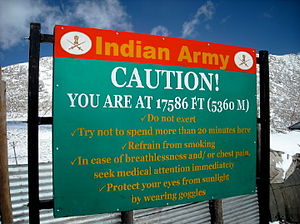Altitude sickness
| Altitude sickness | |
|---|---|
| Synonyms | altitude illness, hypobaropathy, the altitude bends, soroche |
 |
|
| Altitude sickness warning – Indian Army | |
| Classification and external resources | |
| Specialty | Emergency medicine |
| ICD-10 | T70.2 |
| ICD-9-CM | E902.0 |
| DiseasesDB | 8375 29615 |
| MedlinePlus | 000133 |
| eMedicine | med/3225 |
| MeSH | D000532 |
Altitude sickness—also known as acute mountain sickness (AMS), is a pathological effect of high altitude on humans, caused by acute exposure to low partial pressure of oxygen at high altitude.
Although minor symptoms such as breathlessness may occur at altitudes of 1,500 metres (5,000 ft), AMS commonly occurs above 2,400 metres (8,000 ft). It presents as a collection of nonspecific symptoms, acquired at high altitude or in low air pressure, resembling a case of "flu, carbon monoxide poisoning, or a hangover". It is hard to determine who will be affected by altitude sickness, as there are no specific factors that correlate with a susceptibility to altitude sickness. However, most people can ascend to 2,400 metres (8,000 ft) without difficulty.
Acute mountain sickness can progress to high altitude pulmonary edema (HAPE) or high altitude cerebral edema (HACE), both of which are potentially fatal, and can only be cured by immediate descent to lower altitude or oxygen administration.
Chronic mountain sickness is a different condition that only occurs after long term exposure to high altitude.
People have different susceptibilities to altitude sickness; for some otherwise healthy people, acute altitude sickness can begin to appear at around 2,000 metres (6,600 ft) above sea level, such as at many mountain ski resorts, equivalent to a pressure of 80 kilopascals (0.79 atm). This is the most frequent type of altitude sickness encountered. Symptoms often manifest themselves six to ten hours after ascent and generally subside in one to two days, but they occasionally develop into the more serious conditions. Symptoms include headache, fatigue, stomach illness, dizziness, and sleep disturbance. Exertion aggravates the symptoms.
Those individuals with the lowest initial partial pressure of end-tidal pCO2 (the lowest concentration of carbon dioxide at the end of the respiratory cycle, a measure of a higher alveolar ventilation) and corresponding high oxygen saturation levels tend to have a lower incidence of acute mountain sickness than those with high end-tidal pCO2 and low oxygen saturation levels.
...
Wikipedia
